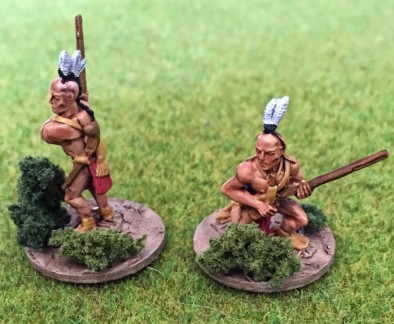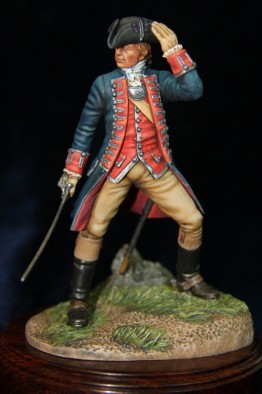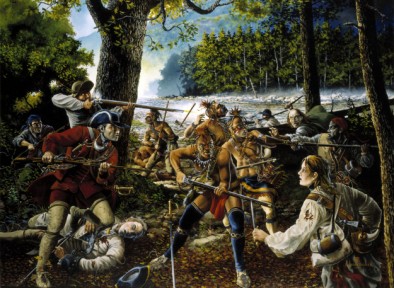Fighting The French & Indian War On The Tabletop: The Battle Of The Monongahela
January 18, 2016 by crew
Welcome back I hope you all had a good Christmas and New Year’s so settle down and relax while we continue our journey through the French & Indian War. You can check out the rest of the series HERE.
In this article we’ll be looking at the Battle of the Monongahela and expanding on the tactics and methods used at the time plus a Scenario for you to try at home using the Muskets & Tomahawks rule set by Studio Tomahawk.
Braddock Sets Out
General Braddock set out from Ireland with the 45th and 48th Regiments of Foot and arrived in America to wage war on the French. General Braddock was tasked with securing the Forks of the Ohio which meant taking the French Forts in the area so their troops would be forced to retreat from the region.
Edward Braddock set out from Fort Cumberland in May of 1755 towards Fort Duquesne in the first organised military expedition of the war. General Edward Braddock decided to construct a road from Fort Cumberland via Fort Necessity to Fort Duquesne and the route of this road was a much debated political issue.
Many people were land speculators at the time and if this new road, that would be the lifeblood of the Ohio Valley, went past their speculations they would become rich and gain political power. General Braddock largely ignored the petitions of the land speculators and decided to take the most sensible route to Fort Duquesne.
Having a force of roughly 2000 men General Braddock’s expedition began to experience problems as their march got deeper into the wilderness. The roads that were originally wide enough for the main infantry body were not suitable for the artillery and wagons that followed the army forcing the men to widen the road and reducing the advance to a crawl.
Seeing his advance begin to stagnate General Braddock split his force into two parts. One was a flying column of approximately 1300 men with the second part containing the remaining men and most of the artillery and wagons. Thomas Gage (who many people may remember ordered the British to seize arms from the Whig’s [incorrectly called Patriots] at Lexington and Concord) was leading the vanguard of this column when they encountered the Native American scouts who informed them that the French forces were approaching.
Captain Baejue Responds
As we've seen earlier in the series the French side of the Battle of the Monongahela was commanded by Captain Beaujeu who only had approximately 100 Troupes de la Marine and approximately 150 Canadian’s. Captain Beaujeu however did not believe he could engage the British successfully with the troops he had and needed the help of the 600 Native Americans who were allied with the French.
The Native Americans were reluctant to join the French for a variety of reasons including not wanting to get involved in what they saw as a European Conflict, and not wanting to risk war with tribes allied with the British. Captain Beaujeuperformed his most famous act when he rallied the Native Americans by taking off his uniform and painting himself in war paint.
While to us this may seem like an impressive act of solidarity and respect it was seen as a hugely radical thing to do at the time - much the same as the President or Prime Minister giving a speech naked to appeal to Nudists. If Captain Beaujeu had survived the battle it is extremely likely he would have been shunned by other officers for his behaviour.
The Battle Erupts
Captain Beaujeu arrived too late to ambush the British and was killed in the opening salvo of musket fire but it is widely believed he had the largest impact on the battle in rallying the Native Americans. After the original volley the British began to organise themselves into the standard line formation that could fire a dense group of shots into a designated area.
However, while the French line troops formed lines and met the British head on the Native Americans and Canadians flanked the British and began skirmishing in groups of two or three. Skirmishing in a group gave you the advantage or being able to distract fire and to always be giving fire.
With their flanks threatened the British began to follow normal protocol which was quite sensibly to form a U shape so you couldn’t be outflanked. This however was ineffective against skirmishing troops and while a group of men firing in line may be able to inflict casualties on another group of men in line they could not hit a man who simply stayed behind a tree.
Put yourself in the shoes of a Canadian skirmishing. You’re behind a solid tree and you notice twenty or so men pointing muskets at you. You wouldn’t leap out from the tree to get off one final shot before you die heroically would you!
You’ll most likely need a new pair of pants and will just stay behind your tree until the men fire at it or chose a new target. If they don’t fire but stay waiting for you to come out then you just sit there for the rest of the battle while the rest of your friends keep shooting at the men in a nice big group.
While we have detailed accounts of the battle it was a fairly simple and yet devastating affair. The British began taking casualties and, like you would do in a European battle of the day, began to pull back. However, there was a problem. There was nowhere to go.
As the British units in front began to pull back they were blocked by their allies behind them who were forced off the road and into the surrounding trees where their commanders soon lost absolute control of their men who became separated in the chaos and easy targets for skirmishers.
As General Braddock and his aide George Washington rallied the fleeing men General Braddock was fatally shot by a skirmisher and George Washington had between one and three horses shot out from underneath him although I believe one to be more correct as George Washington’s life has been greatly embellished by history (not that it really needed to be).
With the loss of their commander and the column in disarray the British began to retreat. This will be covered in the next article in more detail. All in all the British suffered over 500 personnel killed and 450 wounded while the French lost thirty killed and had fifty seven wounded.
To put these numbers into perspective more British troops were killed here than in Pickett’s Brigade than during the charge on the final day at Gettysburg (498).
Try The Battle Yourself
Now, since this is an article on gaming in the French & Indian War I thought I should give you all a scenario to play at home. I played this scenario with a friend of mine and it played quite well and resulted in a fun evening. Remember the scenario isn’t designed to be balanced but rather to re-create the circumstances of the battle while still giving both players the chance to succeed.
You will need...
- 24x British Line Infantry
- 12x Provincials
- A Mounted Officer
- 8x British Grenadiers
Versus...
- 24x French Line Infantry
- 12x Canadian Militia
- 20x Indians
- One Officer
Ignore the rule for Officers not being targets if within a certain distance of friendly troops. All Indian units count at rolling a six on their reaction tests while Captain Beaujeu is alive. If a unit falls back through another unit then that unit immediately loses any positive bonuses of that formation and must spend an action reforming to demonstrate the small confines of the battle.
Happy Gaming and please let me know if you have any questions...
If you would like to write an article for Beasts of War then please contact me at [email protected] for more information!
"Captain Beajue performed his most famous act when he rallied the Native Americans by taking off his uniform and painting himself in war paint..."
Supported by (Turn Off)
Supported by (Turn Off)
"...more British troops were killed here than in Pickett’s Brigade than during the charge on the final day at Gettysburg"
Supported by (Turn Off)
































![How To Paint Moonstone’s Nanny | Goblin King Games [7 Days Early Access]](https://images.beastsofwar.com/2024/12/3CU-Gobin-King-Games-Moonstone-Shades-Nanny-coverimage-225-127.jpg)














































Nice, Is this the same war as the film (last of the Mohicans) is set in? Monroe is the only name in the story I remember with isn’t in this report.
It is Monroe comes in a bit later on
thanks, very different from other battles more chaotic and bloodthirsty.
Glad to see this series return. Equally glad to have some gaming mixed in. I don’t think I have enough troops to do the scenario as written yet but it’s something to look forward to.
Send me a message with what you have and I’ll make sure a future article has something in it for you
I appreciate the offer but seeing your scenarios gives me something to work towards, either for painting or future expansion of my collection.
Excellent article. Gets across some of the unique characteristics of the French and Indian War, or really any war on a frontier:
** Its vast space in comparison to the force levels typically leveraged.
** The vital importance and role played by native inhabitants (since the main “empires” involved can’t deploy very large forces in theater).
** the particular challenges of supply and reinforcement.
** and the savagery typically encountered in frontier warfare.
The Muskets and Tomahawks system looks interesting as well.
Great job, overall. 😀
M&T is a really neat little game system that captures the flavor of the era nicely.